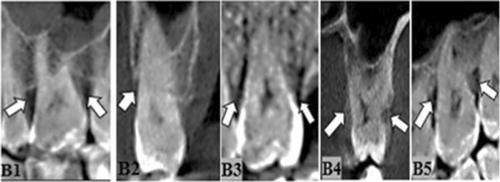Evaluation of Alveolar Bone Destruction Patterns in the Posterior Region of the Maxilla Through Cone Beam Computer Tomography on 361 Consecutive Patients: Effect of Age and Gender
Abstract
Objectives
The aim of this retrospective study is to evaluate the effect of age and gender on the alveolar bone destruction pattern with cone beam computed tomography (CBCT) in the posterior region of the maxilla.
Materials and Methods
The study group included CBCT image records of 361 consecutive patients (180 males and 181 females) aged 20 years and older. Alveolar crest morphology in the maxillary right and left first and second molar teeth on retrospective images was classified as a horizontal or vertical defect (one-walled, two-walled, three-walled, and combined bone defect) on four surfaces (mesial, distal, buccal, and palatinal). Bone crater defects were defined, and furcation involvements and combined periodontal–endodontic lesions (CPELs) were placed in another category.
Results
In 361 patients, 1444 teeth were evaluated from adults between 20 and 63 years of age; 49.9% of the patients were male and 50.1% were female. Female patients had a considerably greater rate of one-walled horizontal damage in the right molar teeth than male patients (p = 0.002; p < 0.05). Patients with combined horizontal destruction in the right and left molar teeth, horizontal destruction in the palatinal, and horizontal three-walled destruction had a significantly higher mean age than patients without these periodontal destructions (p = 0.000; p < 0.05). Males were shown to have statistically higher frequencies of horizontal defects when defects were combined or distally and palatally located.
Conclusions
Age and gender affect the alveolar bone loss pattern. Except for single-walled destructions, it has been found that the frequency of horizontal destruction increases with age. Horizontal destruction in the palatinal along with horizontal three-walled destruction increased with age.


 求助内容:
求助内容: 应助结果提醒方式:
应助结果提醒方式:


